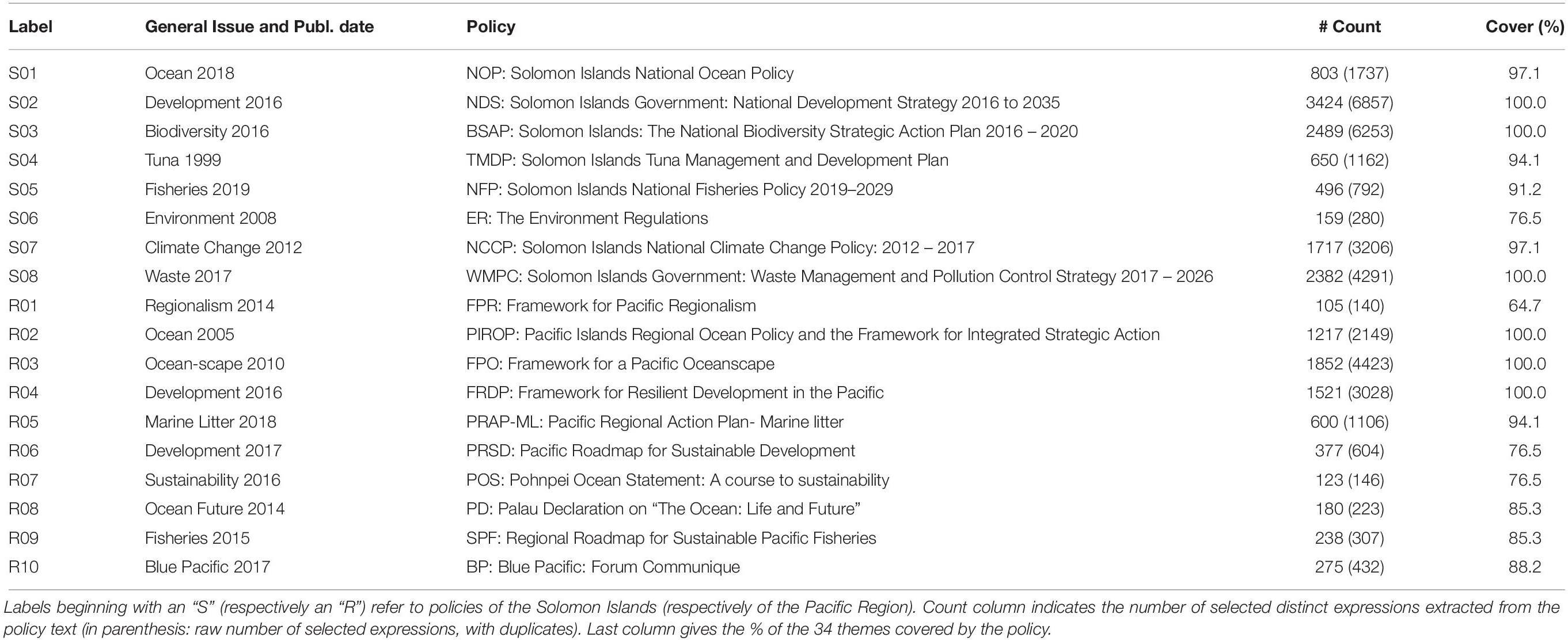- 1Office of the Deputy Vice-Chancellor (Research, Innovation & International), The University of the South Pacific, Suva, Fiji
- 2INSERM, Laboratory Population Environment Development, IRD UMR 151, Aix Marseille University, IRD, Marseille, France
- 3Strathclyde Centre for Environmental Law and Governance (SCELG), University of Strathclyde, Glasgow, United Kingdom
- 4Solidarity, Societies, Territories, Interdisciplinary Laboratory LISST UMR 5193, CNRS – University of Toulouse Jean-Jaurès, Toulouse, France
Oceans are governed by multiple policies at international, regional and national levels. National level policies have traditionally been sector-based, covering fisheries, tourism, environment etc. Recently more integrated and holistic National Ocean Policies (NOP) have been promulgated. The Pacific Ocean also has well-developed regional ocean-related policies spanning decades. The work presented here uses lexicometric analysis to map the interlinkages between regional and national policies to determine if they are evolving synergistically. Focusing on the Solomon Islands, due to its reliance on the ocean and producing a NOP in 2018, 13,622 expressions were extracted from the corpus of 8 national and 10 regional ocean-related policies. Network analysis displayed limited differentiation between the NOP, national sector-based policies and regional policies. Clustering of policies showed progressive splitting of policies from a single cluster, rather than by formation of a number of separate clusters. This behaviour reflects the thematic interlocking of policies: all share many themes, and the more integrative policies add a few additional sectoral themes. The themes rarely addressed in the corpus include energy, agriculture, pollution and education. The NOP was predominantly built on existing national or regional policies and their main themes rather than setting a new direction in ocean governance. The benefit of the NOP may be less about its content itself, but the creation of allied cross-ministerial architecture. With the intense pressure on the oceans and its resources in present times, there will be a growing need for more substantive policy evolution.
Introduction
The Emergence of the Regional Ocean
The Regional Seas Programme, launched in1974 under the auspices of the United Nations Environmental Programme (UNEP) aimed to address the accelerating degradation of the world’s oceans and coastal areas through the sustainable management and use of the marine and coastal environment, by engaging neighboring countries in comprehensive and specific actions to protect their shared marine environment (Ehler, 2006). The Regional Seas Programme implements region-specific activities, bringing together stakeholders including governments, scientific communities and civil societies (UN Environmental Regional Seas Programme, 2016). The approach echoes the Preamble of United Nations Conventions on the Law of the Sea (UNCLOS) which states “the problems of ocean space are closely interrelated and need to be considered as a whole,” (UNCLOS, 1982). This consideration led to the development of policies related to marine resources and to the sea in general which contribute to the need for a multiscale and integrated approach to the ocean (Pyć, 2019).
According to the Report of the 2002 World Summit on Sustainable Development, ensuring the sustainable development of the oceans requires effective coordination and cooperation as well as action at all levels to “promote integrated, multidisciplinary and multisectoral coastal and ocean management at the national level and encourage and assist coastal States in developing ocean policies and mechanisms on integrated coastal management,” (WSSD, 2002). Moreover, the implementation of multilateral environmental agreements such as the Convention on biological Diversity (CBD), CITES (Convention on International Trade in Endangered Species of Wild Fauna and Flora) or CMS (Convention on the Conservation of Migratory Species of Wild Animals) as well as UNCLOS and the Agenda 2030 for Sustainable Development contain synergies at the regional level to foster implementation (UN General Assembly, 2003; UN ESCAP, 2020).
Pacific Regional Ocean Approaches
Regional instruments have become important means of translating global commitments, serving as a nexus for action (Durussel et al., 2017). This is apparent in the Pacific, which although lacking a Regional Seas Programme, has a long history of regional ocean policy, perhaps reflecting the dominance of the ocean in identity, culture, geography, transport, and natural resources (Ehler, 2006).Collectively, the Pacific Island Countries and Territories (PICTs) are custodians of a vast ocean space, covering at least 40 million square kilometers, which approximately is 98 percent of the Pacific region (Fache et al., 2016). It is fair to term the Pacific Islanders as “the people of the sea,” who derive substantial socioeconomic and environmental advantage from the ocean (Pratt and Brierley, 2016).
Issues related to the sustainable management and development of the colossal Pacific Ocean are challenging (WORLD BANK, 2017; Searight et al., 2019). Consequently, the PICTs have developed frameworks and agreed to numerous commitments at regional and international levels in a bid to manage the ocean (IPCC, 2014; Pratt and Brierley, 2016). Regional policy guidance on oceans management was historically derived from the Pacific Plan and the PIROP (Pacific Islands Regional Ocean Policy and the Framework for Integrated Strategic Action; Pratt and Govan, 2010). In 2014, the Pacific Leaders synonymously decided to replace the Pacific Plan with the Framework for Pacific Regionalism (Pacific Islands Forum Secretariat, 2014). When the emphasis was shifted from Small Islands Developing States to Large Ocean States in 2015, the ocean states were recognised as a “ocean continent” (Chan, 2018). To this effect, in 2017 the Blue Pacific narrative was endorsed by the Pacific Islands Forum (PIF) Leaders (Searight et al., 2019).
Regional institutional arrangements have followed the development of regional ocean approaches. Cross-sectoral cooperation and coordination of policies is prominently handled by the Pacific Islands Forum which was established in 1971 and its Council of Regional Organisations of the Pacific (CROP) was formed in 1988 by Forum Leaders, complimented by the Office of the Pacific Ocean Commissioner (Quirk and Harden-Davies, 2017). Council of Regional Organisations of the Pacific agencies (like SPREP, SPC, FFA, and USP) support the PIF. A Pacific Ocean Commissioner and the Office of the Pacific Ocean Commissioner (OPOC) was set up on request of PIF Leaders to focus on regional ocean management (Pacific Islands Forum Secretariat, 2015). OPOC is supported by the POA (Pacific Ocean Alliance) which is a broad coalition of ocean stakeholders from across the region, which supports inclusivity through channels of involvement of local communities and stakeholders (Evans et al., 2019).
Multiple Ocean Policies
Notwithstanding, regional and international instruments for the ocean, nation states have agency with respect to the ocean (Pratt and Govan, 2010). This operates as multiples layers, as member countries of ocean-related international agreements (such as UNCLOS, CMS, CITES, CBD) and regional agreements through PIF (such as the framework for a Pacific Oceanscape), as well as direct responsibilities for their national ocean jurisdiction through UNCLOS (Pacific Ocean Commissioner, 2021). Thus, from a national perspective, national ocean-related sector policies, such as in fisheries, tourism and environment, have been promulgated (Pacific Ocean Commissioner, 2021).
More recently efforts have been made for the development of more holistic ocean policies, often called National Ocean Policies (NOPs) or similar, especially in Pacific countries (Vierros et al., 2016). As opposed to a more traditional sector-based management framework related to the likes of fisheries (Allan, 1957), environment and conservation (Keesing, 1993), NOPs for Pacific countries focus on the sustainable management of ocean, its resources and boundaries (Sloan et al., 2020; Pacific Ocean Commissioner, 2021). The NOP is set out to provide a cross cutting transdisciplinary instrument which remarkably has a unique disposition and can tackle the many challenges the country is exposed to (Keen and Masu, 2019; Sloan et al., 2020; Pacific Ocean Commissioner, 2021).
The work presented here focusses on Solomon Islands as it is a member country of the PIF and other regional CROP agencies through which regional ocean-related policies are disseminated. The Solomon Islands also has ocean-related sector policies and a recent National Ocean Policy approved in 2018. The NOP of the Solomon Islands followed concerted efforts through “Ocean 12”1 and its working group, the Government of Solomon Islands, Provincial Government staff, other stakeholders (like MACBIO, SPREP, and BMU) and community members country wide. The NOP states its alignment with existing national policies (like the National Development Strategy 2016–2035, Solomon Islands National Climate Change Policy 2012), regional policies [like Pacific Islands Regional Ocean Policy (PIROP 2015), Pacific Oceanscape 2011] and international policies and commitments [like CBD, UN Sustainable Development Goals (SDGs), UNCLOS, (SINOP, 2018; Keen and Masu, 2019)].
The Contemporary Ocean Policy Nexus
The Pacific Ocean is steadily becoming congested with complementary policies (Song et al., 2019). Many policies antecede or overlap with the publication dates of others, including international conventions, thereby creating a pre-existing policy frame into which policies should conform, increasing diffusion and limiting evolution (Song et al., 2019). Already, noting the possible fragmentation between policy regimes, calls have been made to increase the interplay and synergy (i.e., co-operation, coordination and action) between the regional and global levels of ocean governance, especially including Areas Beyond National Jurisdiction (Gjerde et al., 2018). However, focusing on the area within national jurisdiction, the emergence of multiple regimes is also apparent, forming around the regional policies, national sector-based policies and NOPs. Whilst policies have been assumed to be supportive and complementary, limited detailed analysis of regional and national ocean-related policies have been undertaken (Dorah, 2007).
For the Solomon Islands, a Least Developed Country (LDC) and highly vulnerable to natural disasters (Bergin et al., 2019), the ocean represents a vital resource and transport route between the >340 inhabited islands (Barclay and Cartright, 2007; UNOCHA (United National Office for the Coordination of Humanitarian Affairs), 2021). The work presented here focuses on the Solomon Islands and the interplay between the regional and national ocean-related policies as well as the 2018 NOP. The aim of the research is to map the interlinkage between regional and national ocean-related policy, in order to determine if policies are developing synergistically. Specifically, the research aimed to define the positioning and role of the recent NOP within the national and regional policy architecture.
Materials and Methods
Policy Selection
Policies were selected through literature review, shortlisting and then verification/amendment by appropriate representatives. The main ocean-related policies were identified through a summary review of reports and literature to draw up a short-list of all substantial ocean-related policies at a national and regional level. The shortlist of national policies was the amended/validated by selected representatives. For the national policies three representatives from the Ministry of Fisheries and Marine Resources and one International Fisheries Law Specialist from the Solomon Islands were consulted (Transform, 2007). For the regional policies, representatives from the Office of the Pacific Ocean Commissioner were consulted. The final list, approved by the selected representatives, included eight Solomon Islands policies (S01 – 08) and ten regional policies (R01 – R10) is provided in Table 1.
Policy Profiles and Similarity
The approach used to analyse the policies is based on lexicometric content analysis, which measures the frequency of use of words within the studied texts. From these usage frequencies, mathematical and statistical indices can be derived which allow the interlinkages between texts to be interrogated and emergent perspectives to emerge. The specific methods used and described here have been designed and coded specifically for the particular requirements of the analysis rather than using proprietary lexicometric software. The application of the employed lexicometric analyses are novel for ocean policy and for the Pacific, but lexicometric analyses have been widely used in other studies including law and public policy (Boulet et al., 2019).
The extraction of the information for the analysis from the corpus of 18 policy texts into a structured hierarchical classification involvedthe following 6 steps (a set of definitions, a list of themes and further technical detail on steps 2, 5, and 6 are all provided in the Supplementary Material):
• Step 1: convert documents from .PDF to.txt format and cleaning up the files;
• Step 2: extract noun phrases (or “expressions”) from the corpus of policy texts;
• Step 3: edit and filter the list of all the distinct expressions extracted from the corpus. The list obtained forms the vocabulary of the corpus;
• Step 4: identify the main themes of interest for the characterisation and analysis of the content of policies. Partition of all themes into domains;
• Step 5: each word of each expression is put in its canonical form, its lemma, and each lemma is assigned to one and only one theme. The hierarchy lemmas < themes < domains form the taxonomy;
• Step 6: for each policy, for each theme, counting the number of distinct lemmas assigned to the theme and found in the expressions of the text. The distribution of the number of lemmas by theme constitutes the profile of the policy. Estimation of the similarity between the policies taken by pairs.
Step 1 is commonly performed in natural language processing (NLP) of textual corpora but it is not a fully automated process. It includes the homogenisation of texts (UTF08 encoding), the elimination of layout markers and references to figures, etc. For this reason, text tables have been omitted unless they presented useful information in textual form.
Step 2 uses algorithms for the automatic extraction of noun phrases. However, this extraction is a relatively complex task which requires in particular the parsing of the text into sentences, then their parsing into tokens (most of them being words), followed by a syntactic analysis making it possible to identify the noun phrases through the grammatical function they occupy in each sentence. In order to ensure a good recall of this step, we use three free- or share-wares as detailed in the Supplementary Material. The lists of expressions produced by these three approaches are then merged into a single list, keeping both any nested expressions and the phrases into which they fit (e. g. “environmental impact assessment” is nested in “application of environmental impact assessment”).
This resultant single list is then analysed (step 3) to remove all expressions that have an indeterminate or too general meaning when they are detached from the sentences in which they were used. Reading them in a list, outside the textual context, does not allow to link them to a theme or policy sector (e. g. “annual growth rate,” “potential earnings”). After this lexical filtering, more than 13,500 distinct expressions endowed with an autonomous meaning (independent of the context), form the vocabulary of the corpus of 18 policies. Each expression or noun phrase is made up of one or more words.
A set of themes is then formed from the vocabulary. The approach chosen in this fourth step is based on the differentiated and complementary expertise of the co-authors to identify these themes rather than on a purely lexical-semantic analysis or a clustering statistic. In this way the identified themes are meaningful in the context of the making of policies and regulations related to the oceans and marine resources, socio-ecological changes and development, in particular in the specific context of the Pacific region. The 34 themes thus obtained were divided into 5 domains, “activities,” “development,” “environmental changes,” “governance,” and “law, policy, and politics” (see Figure 1).

Figure 1. Taxonomy built from the vocabulary of significant autonomous expressions extracted from the policy corpus. The total field of the taxonomy is partitioned in five domains – Activities, Development, Environmental Changes, Governance, and Law Policy Politics. Each domain is partitioned into themes which number of related lemmas (see text) and label are given into brackets (see the Annex for details).
In step 5 (see Supplementary Material for details), each word entering the composition of an expression of the vocabulary, except stop-words, is lemmatised. More than 3,800 of such lemmas were obtained and each lemma is then assigned to a theme. The hierarchy formed by the list of lemmas assigned to the 34 themes themselves partitioned into five domains. This constitutes the taxonomy of the corpus of policies analysed. By construction, an expression comprising several lemmas can be linked to more than one theme, for example, “advocacy for low carbon development” is related to the themes “law” [label: LAW], “environment and climate change” [ENCC] and “development” [DEVe] via the lemmas “advocacy,” “carbon,” and “development,” respectively. Acronyms and frozen expressions are not lemmatized but directly related to a theme.
The policy texts are taken one by one in step 6, to search for each expression. For each policy, the number of distinct lemmas assigned to each theme is counted. The presentation of this result in the form of a histogram constitutes the profile of policy. By way of example, the profiles of the similar policies S01 Solomon Islands National Ocean Policy and R03 Framework for a Pacific Oceanscape are presented in Figure 2.
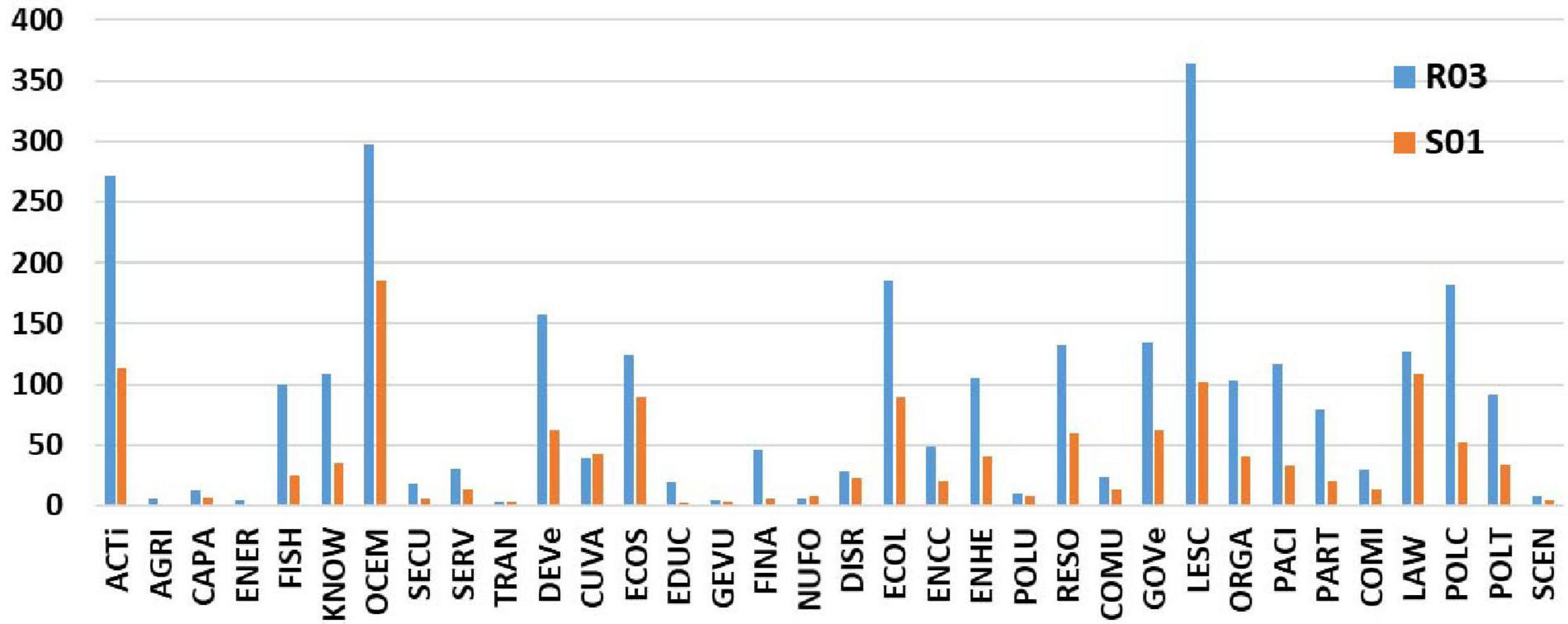
Figure 2. Profiles of the Solomon Island’s policy S01 and the regional policy R03. The numbers of lemmas found in relation to each theme are indicated on the y-axis.
Details of the definitions of the hierarchical taxonomy and further definition of the 34 themes are provided in the Supplementary Material.
To ease the comparison between these policy profiles a cosine measure of similarity is provided (e.g., Yearwood and Wilkinson, 1997; Graesser et al., 2000; see Supplementary Material) so that two policies presenting the same relative number of lemmas in the same themes will be of maximum similarity (cosine = 1). Two policies dealing with distinct themes will be of maximum dissimilarity (cosine = 0).
Policy Networks and Clustering
Beyond the profiles of policies and the measurement of their pairwise similarity, further understanding of the inter-connections between the policies and socio-environmental and development themes can be elucidated.
The counting of lemmas by theme was dependent on the identification of expressions and the assignment of the lemmas resulting from these expressions to a theme. This approach provided meaningful results for establishing the profiles of policies and was relevant for comparing them (having been built on the same mould). However, we wanted to establish a more robust policy network for analysis.
For this purpose, we now only consider the Boolean information indicating whether or not a theme was addressed by a policy. Note that the importance of a theme in a policy or in a regulation is not necessarily reflected by the number of expressions or lemmas that refer to it. A low number of term occurrences is sometimes the weak signal associated with the emergence of a new theme (Lajaunie and Mazzega, 2016; Lajaunie et al., 2018). On this basis, a non-oriented graph (network) was constructed as follows: each policy was a node to which the corresponding label was attributed (see Table 1); a link was established between the policies (nodes) P_j and P_k (jk) if they addressed at least one same theme; a weight Njk was assigned to the link between two policies which address the same Njkthemes.
This reduction from the information carried by the counting of lemmas by theme, to just the occurrence of themes in a policy, reinforced the robustness of network analysis while sacrificing its lexico-semantic finesse. Thus, as will be seen in Section “Results”, the graph produced in this way was complete. In other words, there was always at least one theme addressed by any pair [P_j,P_k]. To better understand the thematic articulation of all policies, we must therefore take into account the weights of the policies interlinkages.
The distance between P_j and P_k is defined as the inverse of the weight of their mutual links. In other words, the greater the number of common themes that two policies address, the lower their distance. Considering all policy pairs, a dendrogram was built that showed which policies group together in clusters and how these clusters gradually merge into larger clusters with the increase in the distance tolerated for being part of the same cluster (see Supplementary Material, section “Materials and Methods”).
As with policies, it is possible to produce a graph whose nodes were themes linked in pairs when they were addressed by at least one and the same policy. Each link was weighted by the number of policies that address the two themes. An analysis of the strength of these interconnections was also carried out via the production of the dendrogram representing the clustering of themes as a function of their mutual distances.
Results
National and Regional Policies
A total of 13,622 expressions, assigned to 1,826 lemmas, forming the 34 themes subsumed by five domains, were harvested from the national and regional policies (see domains and themes in Figure 1).
Each policy has been profiled (Figure 2 shows some of them). Beyond the information provided by the analysis of each profile, their comparison gives indications on the similarity of their treatment of the various themes. Figure 3 indicates, for each policy, the most similar policy and the most dissimilar policy. The maximum and minimum similarity scores are clearly distinct for all policies, which expresses important differences in the balance given to the various themes in the different policies. If we consider the Solomon Islands policy group on the one hand, and the regional policy group on the other hand, it is notable that several policies find in the other group the most similar policy, or on the contrary the most dissimilar one. The similarity of the distribution of lemmas by topic is often more prominent in the other policy group. In other words, there is no clear and consistent differentiation between national and regional policies.
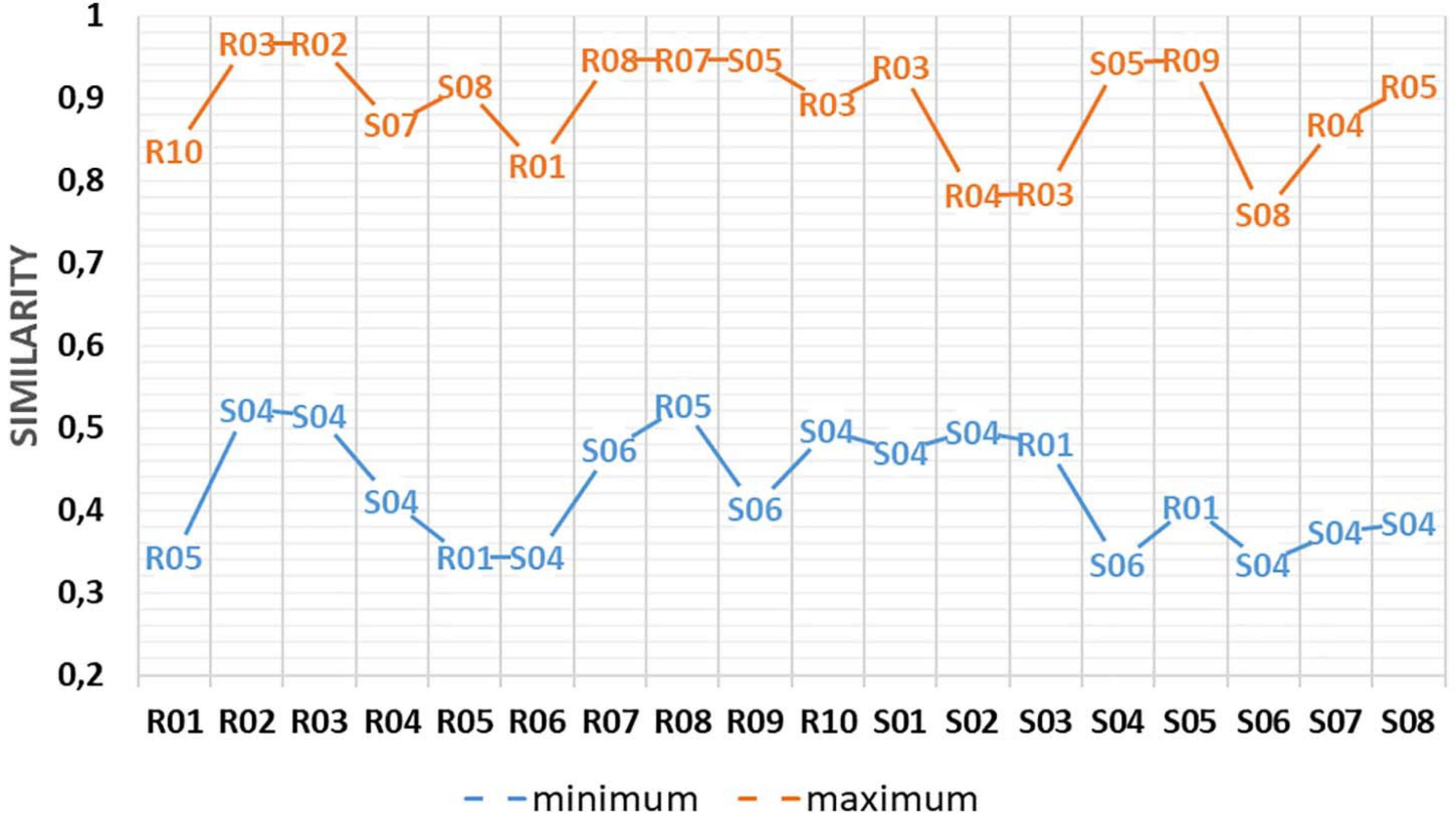
Figure 3. The highest (top orange curve) and lowest (bottom blue curve) cosine-similarity (value on the y-axis) with other policies of each policy named on the x-axis (see Table 1 for the policy labels).
For example, the similarity measure for policies, which profiles are shown in Figure 2, indicates that ocean policies S01 and R03 are very similar, whereas S04 on the contrary is, among the 16 other policies, the most dissimilar from S01 and R03.
National and Regional Policy Networks
Beyond the similarities of policies, the information permitted an analysis of the interlinkages between the national policies and regional policies, to be undertaken. For regional policies the most interlinked policies were PIROP (R02), FPO (R03), and FRDP (R04) (Figure 4). These three regional policies displayed a shared use of all 34 themes. The PRAP-ML (R05) is also strongly linked to this triad but two themes are not shared, the “capacity” and “energy” themes. The BP (R10) policy is even less connected with the triad, sharing 30 themes with the policy triad and 29 with the PRAP-ML policy. POS (R07) and PRSD (R06) were moderately linked to other policies, however, FPR (R01) was weakly connected to most regional ocean-related policies, suggesting differential narratives between regionalism and the Ocean.
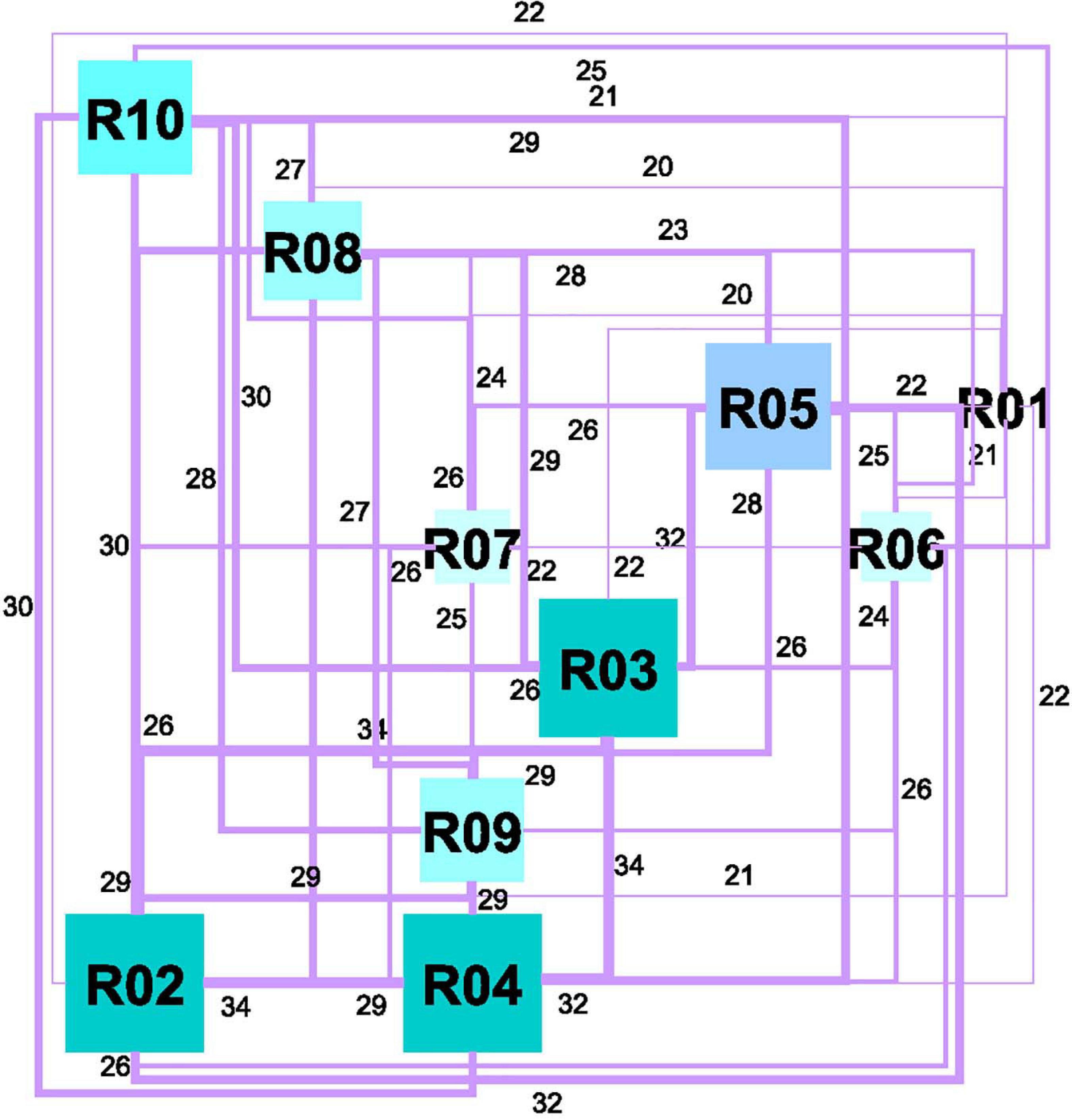
Figure 4. Interlinkages between regional policies. Each box represents a policy indicated by its label. Two policies are linked if they both address the same N themes (N being the weight indicated on the links); links with higher weights are thicker, and lines with weights <20 are not labelled. Box size is related to the sum of the weights of its links.
The Solomon Islands ocean-related policies provide a general picture of strong interlinkages between most policies (Figure 5). Another triad stands out here with maximum connectivity between policies NDS (S02), BSAP (S03), and WMPC (S08); each of these three policies take into account all the 34 themes. The NOP (S01) and (NDS) (S02) are well connected to most of the other policies, suggesting that aspects NDS published in 2016 are embedded within the NOP of 2018. Tuna, fisheries and climate change (S04, S05, S06, respectively) are also well connected to the NOP and NDS, suggesting good coherence. However, ER (S06) is poorly linked to other ocean-related polices, suggesting limited inclusion of the identified ocean-related expressions.
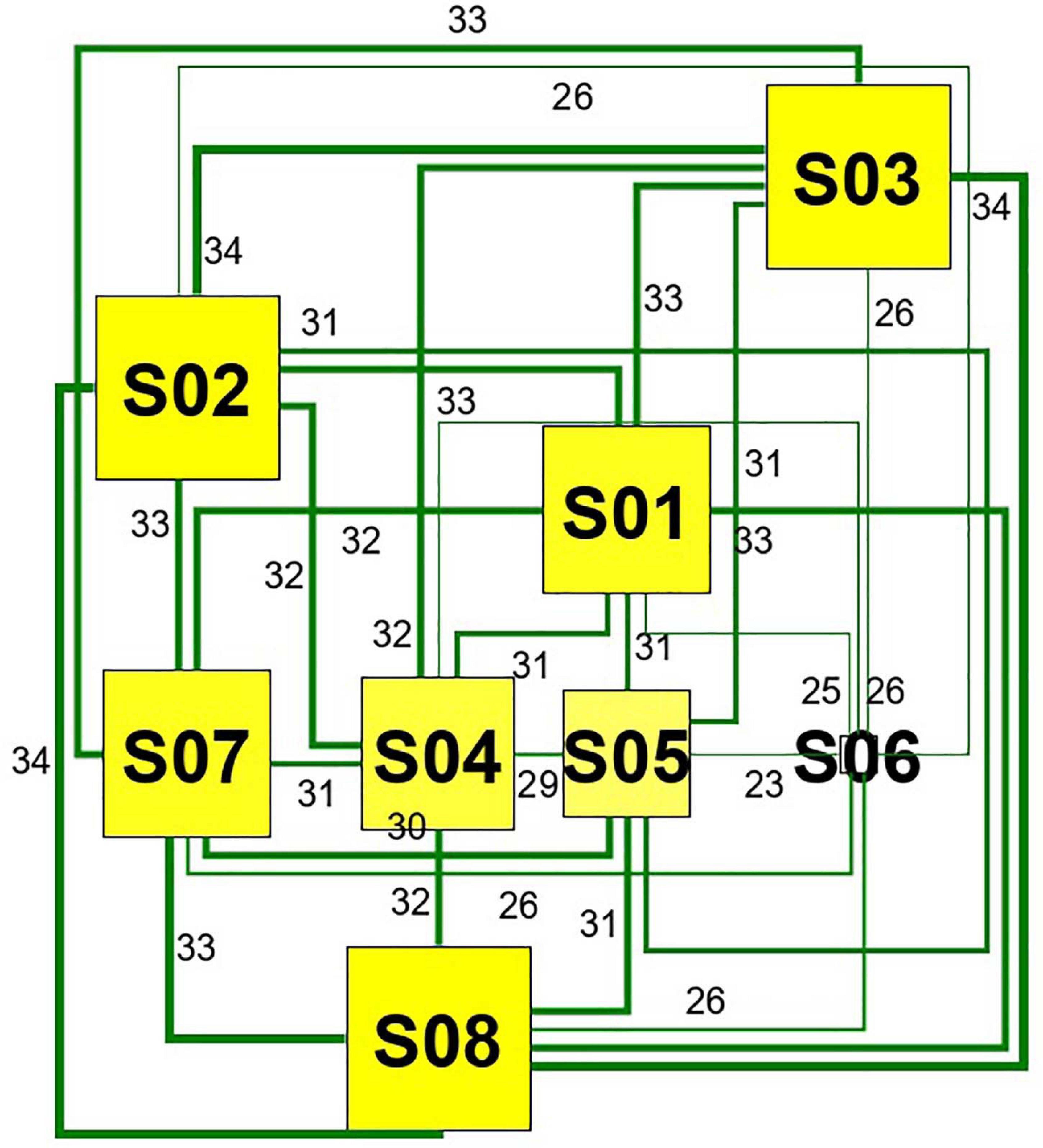
Figure 5. Interlinkages between Solomon Island policies. Each box represents a policy indicated by its label. Policies are linked if they both address the same N themes (N being the weight indicated on the links); links with higher weights are thicker. Box size is related to the sum of the weights of its links.
Integration of National and Regional Policy
Combining regional and national policies we see a degree of integration at theme level (Figure 6). The regional triad (R02 – 4) as well as the Solomon Island’s triad of policies (S02-3, S08) appear on the diagram as large boxes due to the high amount of links (the addition of the other group of policies does not change the links and weights presented in Figures 4, 5). Each policy of each of two triads deals with 34 themes, thus the connection between each component of the two triads is also necessarily maximum. The national policies of S04 (TMDP), SO5 (NFP), and S07 (NCCP) are also strongly linked to regional triad sharing >30 themes. This initial interpretation suggests that the regional triad and a majority of the national policies are so closely interlinked they are largely overlapping at the theme level.
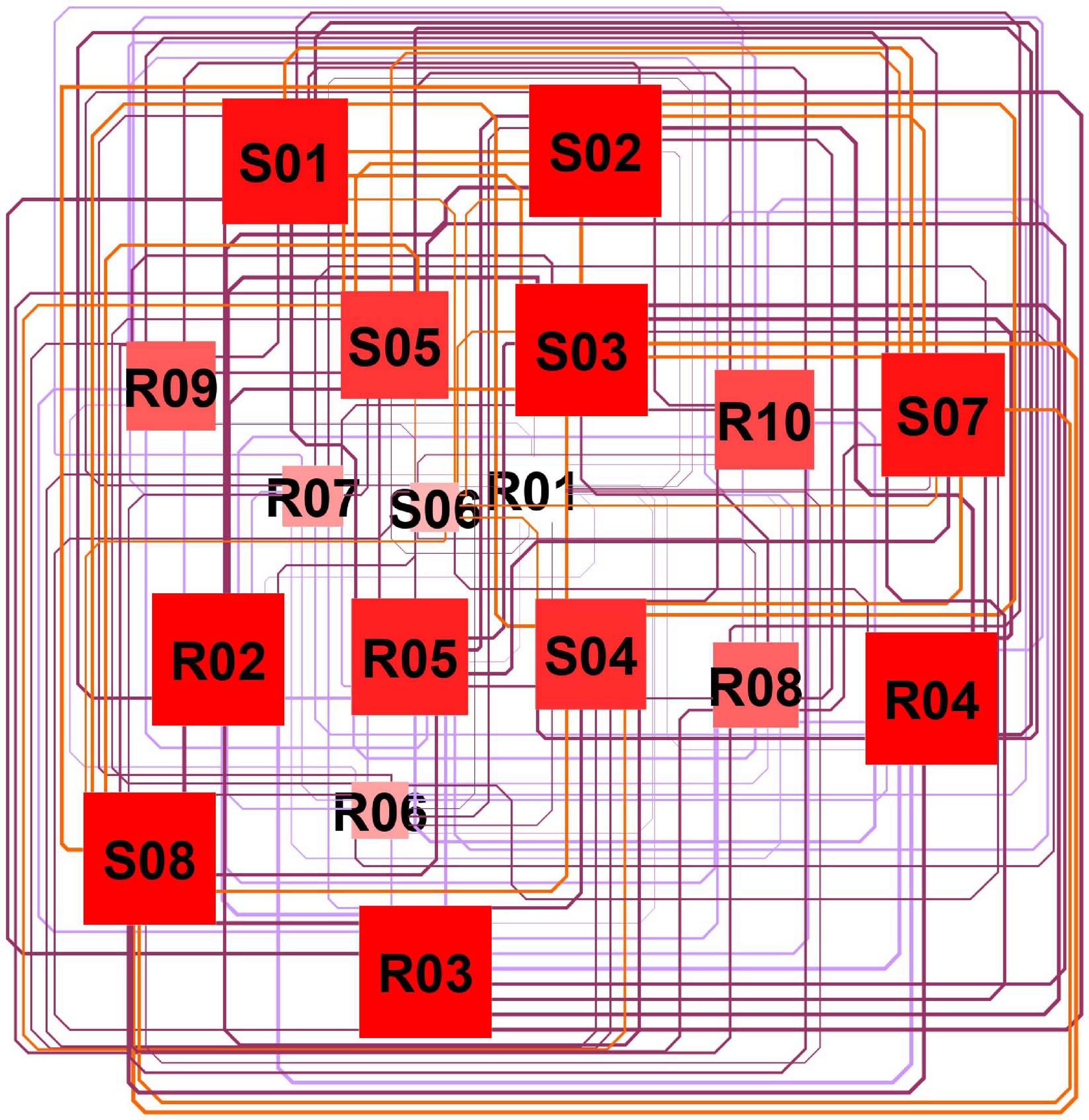
Figure 6. Network of the regional and Solomon Island’s policies. Policy nodes with higher level of interlinkages are larger; links with higher weights (not shown) are thicker. Regional to regional (resp. Solomon Islands to Solomon Islands) policies are in light purple (resp. orange); links between regional and Solomon Islands policies are in dark violet.
Lower levels of theme interlinkages are in fact found in other regional policies including PRSD (R06). POS (R07) and PD (R08) which are weakly linked to the regional triad, the main Solomon Islands group, and also each other. However, most notable is the Framework for Pacific Regionalism (FPR; R01) which is weakly linked to most other policies (small size of box in Figure 6). The Blue Pacific Communique (BP; R10) has a medium level of linkage to other policies overall, however, it has the lowest level of linkage to FPR (sharing just 21 themes) of all studied national and regional policies.
Preliminary interpretation of national and regional policy nexus suggests that the NOP (S01) is well aligned to the NDS (S02), but it is also highly linked to a group of existing national ocean-related policies. Consequently, the NOP is not providing increased or differential policy dimensions to those that already existed in sector-based ocean policy. The NOP, along with its allied national ocean policy cluster, is closely related to the regional triad (PIROP, FPO, and FRDP; R02 – 4), this group shares a high level of themes between them with little differentiation. BP (R10) shares medium levels of connectivity with the regional and national collective group. Finally, FPR (R01) has limited connection to any policy, suggesting that regionalism dimensions are not embedded in regional or national ocean policies, including the Blue Pacific (R10).
Deconstructing the Policy Nexus
To move to a more structured basis for deconstructing the policy nexus, a dendrogram was constructed (Figure 7, top diagram), which shows how some policies gather in clusters when the distance tolerated between policies increases. The first (and single) cluster formed appears at the right most of the dendrogram; it gathers the six policies, formed from the regional policy triad, of FPO(R03), PIROP(R02), and FRDP (R04), with NDS (S02), BSAP (S03), and WMPC (S08) of the Solomon Islands. Each of these policies develop the full set of 34 themes, as shown on Figure 7 bottom panel. Therefore, taken by pair they have the minimal distance and form the most central2 and robust set of policies in our corpus.
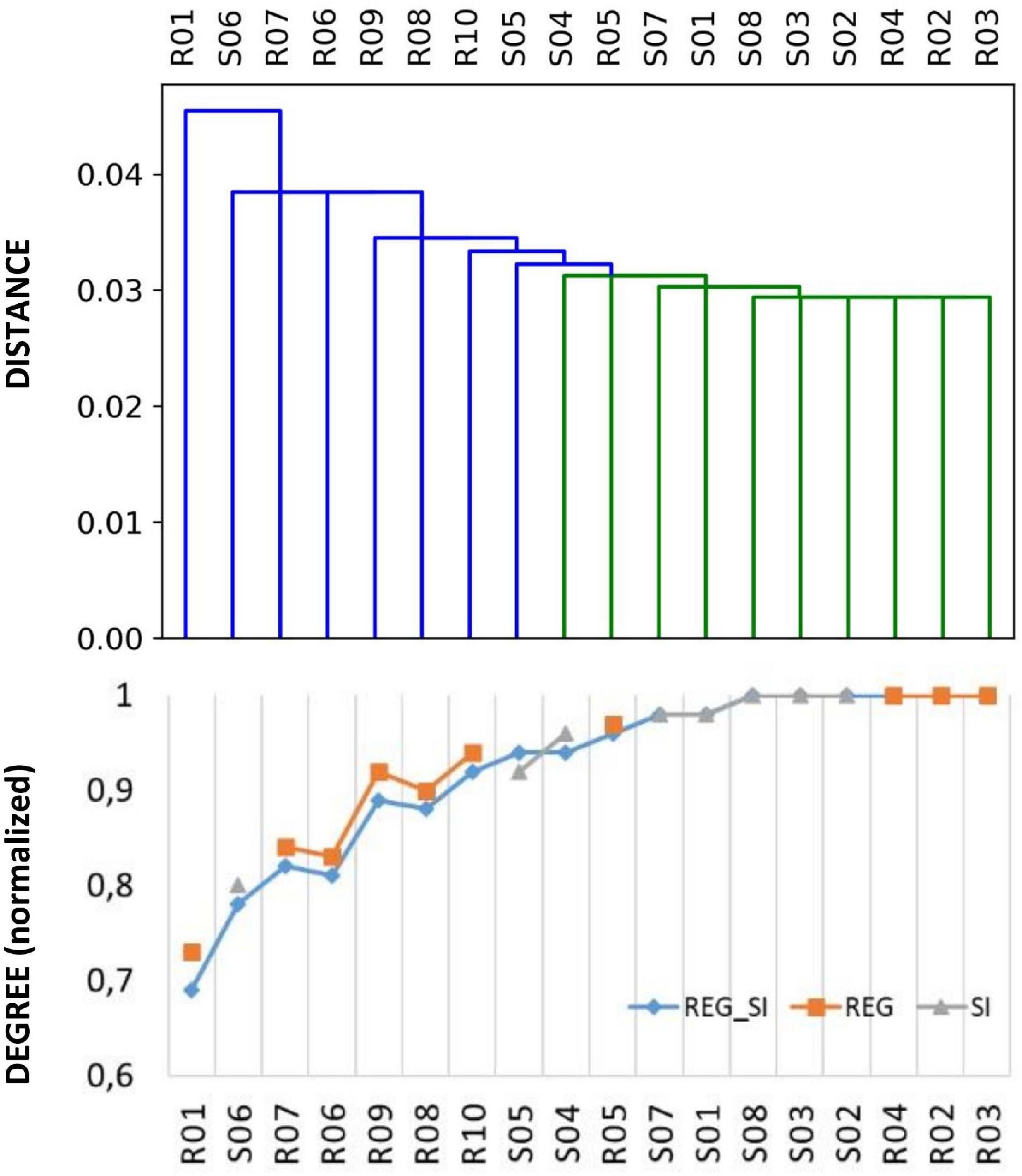
Figure 7. The dendrogram on top shows how policies join in increasingly larger clusters when their distance (on the y-axis, see Section “Policy Networks and Clustering”) decreases from left to right. Bottom curves show that this behavior is well related to the degree of each policy (sum of the weights of its links) in the network of regional (REG; orange squares; see Figure 4), Solomon Island’s (SI; grey triangles; Figure 5) and regional and SI’s policies (REG_SI; blue dots; Figure 6). Policy degrees are normalised by the higher degree found in each network.
The National Ocean Policy (NOP – S01) and climate change (NCCP – S07) policies also show a strong connectivity – sharing 33 themes – with the previous central set. In the middle there is a combination of sectoral (marine litter PRAP-ML R05, tuna TMDP S04, then fisheries NFT S05, and fisheries SPF R09) and more integrated policies (Blue Pacific BP R10, ocean future PD R08) from both regional and national sources. Even weaker links (increasing distances) are found with the regional PRSD (R06 development) and POS (R07 sustainability) policies, and the national regulations ER (S06 environment). Again, FPR (R01) has highest distance suggesting that ocean policies are not capturing regionalism as laid out in FPR.
The whole dendrogram demonstrates that there are not several clusters separated from each other but rather policies which cover an increasing number of themes (when reading Figure 7 from left to right). This explains the incremental monotonic growth of policies (Figure 7 bottom), which are homothetic to the persistence of a single cluster (Figure 7 top). This thematic interlocking of policies does not distinguish between regional policies on the one hand and national policies on the other.
Key Ocean Constructs
The prior analysis has provided results on the distances and similarities between national and regional policy instruments. This section analyses the various ocean constructs, or themes, that are used within the policies. The interlinkages between themes form a complex array with some themes being highly linked and other weakly linked (Figure 8). The node size can be small when there are minimal interlinkages, for example with energy and agriculture, but also with capacity and education. Alternatively, highly linked nodes are interlinked to nearly all other nodes, such as health of the environment and knowledge.
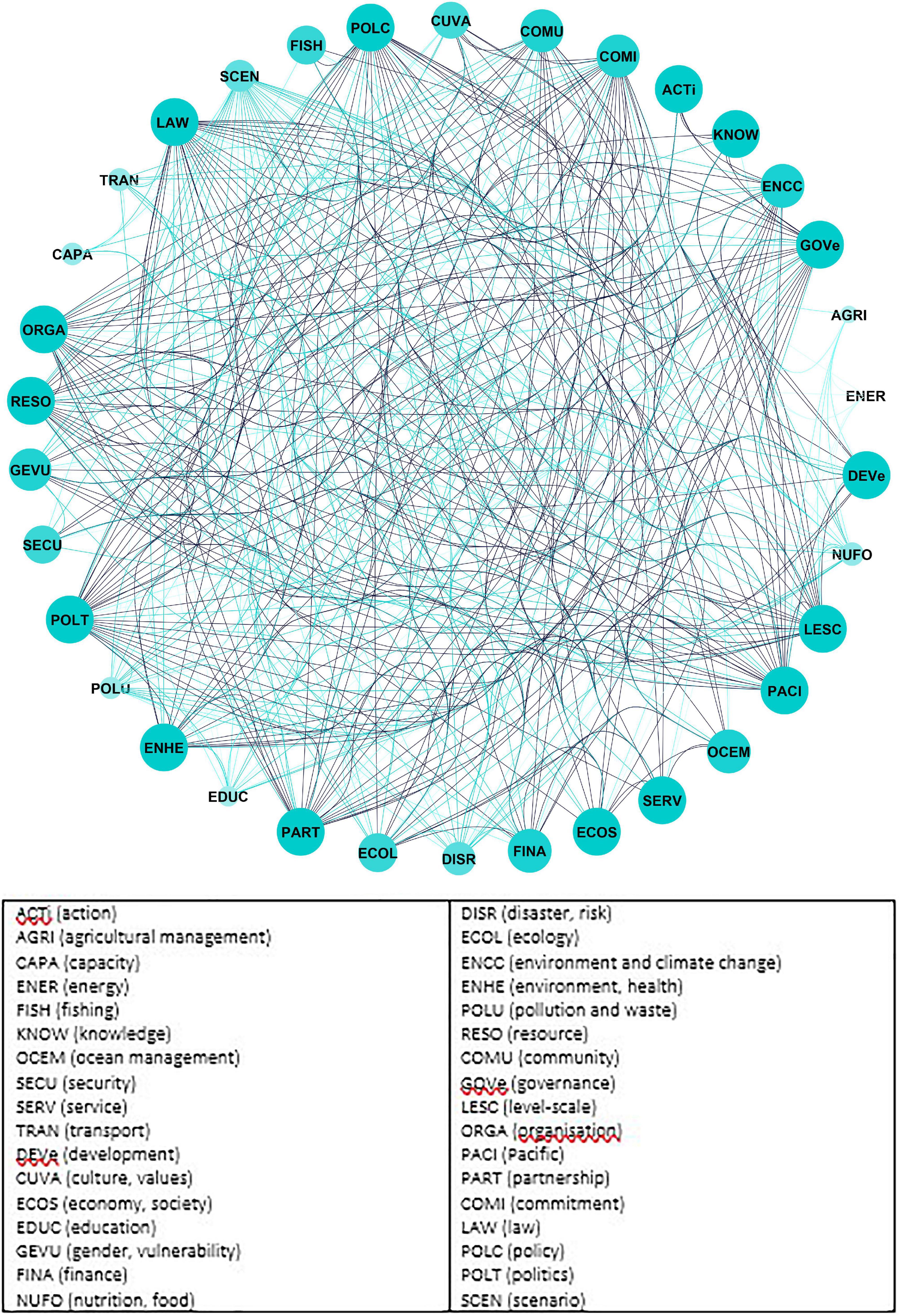
Figure 8. Network of the 34 themes. Each node represents a theme indicated by its label. Two themes are linked if they are both addressed by the same N policies (N values not shown). The ball size is related to its level of linkage (defined as the sum of the weights of its links); with higher weights being represented as darker shading. Theme summary description in table below, for further detail and description of lemmas in each theme see Supplementary Material.
Figure 8 shows that a few themes are poorly linked to the other themes in regional or national policies. They concern important policy sectors: Energy, Transport, Agriculture, and Pollution and Waste. Additionally, they also refer to means to reach the objectives of the policies through Capacity Building and Education (two of the 34 themes illustrated by Figure 8 under the CAPA and EDUC labels).
This limited connection could be explained by various factors. First, these specific themes are addressed mainly by sectoral policies as in the case of waste and pollution national policy WMPC (S08) or the Pacific Regional Action Plan-Marine litter (PRAP-ML R05). Energy, Transport, Nutrition and Food or Education are considered together under the head title “Development sectors” in the Framework for Resilient Development in the Pacific (FRDP R04). Second, these themes might be discussed in other political arenas and they are to be taken into account by UN agencies such as the International Maritime Organisation (IMO) for transport or UN ESCAP – which the secretariat has been requested by member States to facilitate the dissemination and exchange of information by “increasing the coherence and availability of energy statistics and policy-related information.”3 when it comes to Energy. The themes Nutrition and Food concern various political sectors which may result in cross-sectoral tensions among policymakers and stakeholders such as between the food industry on the one hand and the health sector on the other hand (Dodd et al., 2020). Nevertheless, while the population in Solomon Islands rely heavily on agriculture and small-scale fisheries as the main sources of food and income (Keen et al., 2018), the lemma “agriculture” does not appear once in the NOP (S01). It can be explained by the fact that the NOP refers to a more integrated objective “Ensure sustainable food and nutritional security.” More generally, it indicates that it is crucial touse an iterative process to integrate complex scientific knowledge into policies in order to formulate truly integrated policies.
However, interrogating such networks along specific dimensions are necessary to extract conclusions from such entanglements. The previous analysis has showed that there is a commonality between many oceans related national and regional policies, but this analysis focusses on differentiation between national and regional policies. To do this analysis required accessing more detailed information at the sub-theme level from the lemmas.
If national and regional policy use a similar number of lemmas of each theme, then there is evidence that the importance of the theme is similar between the national and regional policy. If, however, regional policy uses many lemmas under the theme, but national policy uses only a few then the proportion of lemmas, then it can be construed that the regional policy has develop that theme more strongly than the national policy. In this analysis we compare the proportion of lemmas used for each of the 34 themes separately for national and regional policy (Figure 9).
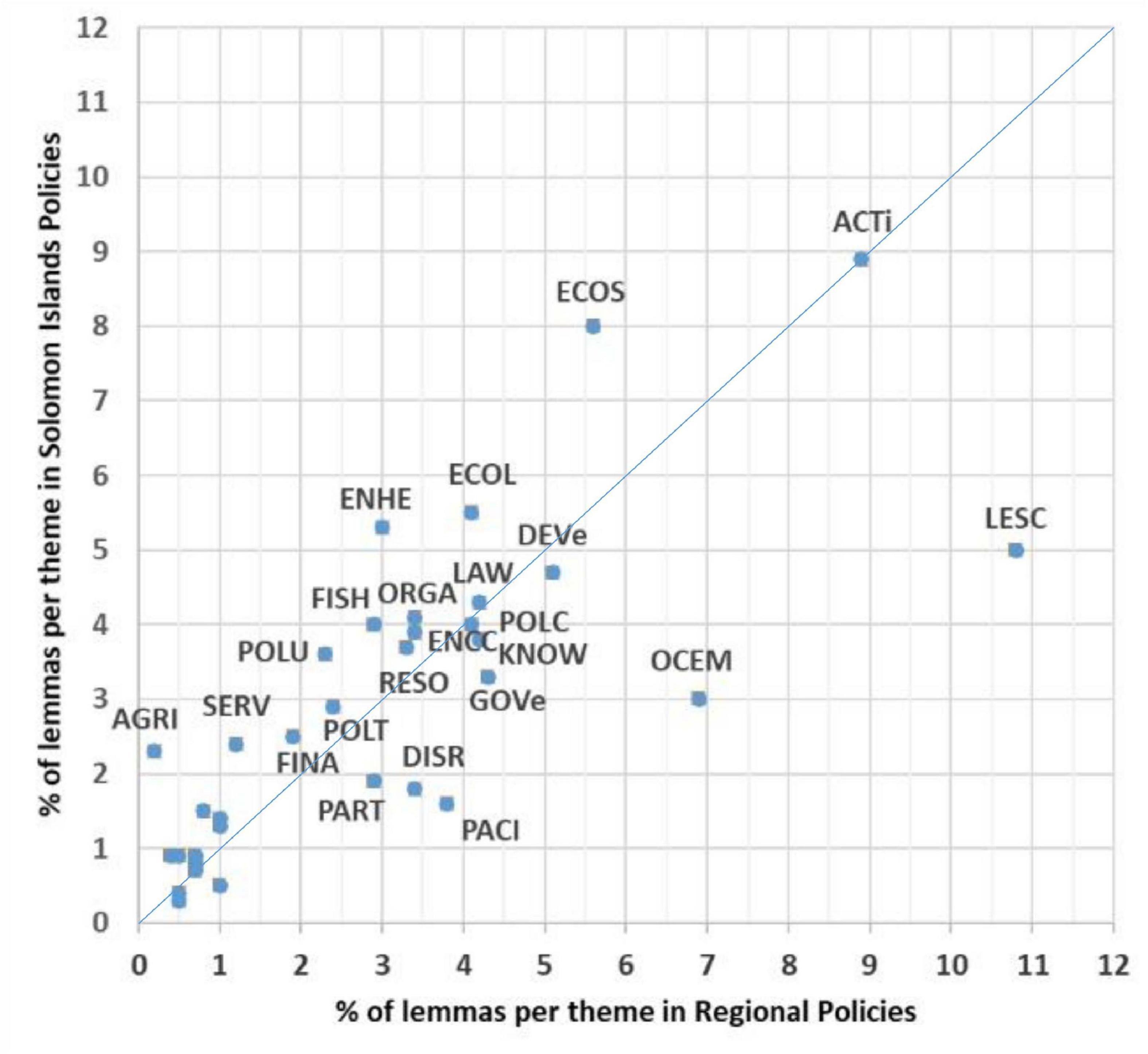
Figure 9. Percentage of lemmas dedicated to each theme in regional policies (x-axis) and Solomon Islands policies (y-axis). Equal percentage of lemmas about the same theme in regional and national policies align to the diagonal line or parity. The themes above the diagonal are more developed in Solomon Island policies, whereas those below are more developed in regional policies. Labels of themes below 2% limit on both axes are not given for the readability of the figure (i.e.) CAPA, ENER, SECU, TRAN, CUVA, EDUC, GEVU, NUFO, COMU, COMI, SCEN.
Themes which are above the line of parity have a higher proportion of lemma use in national policies than the regional policies. Thus, economy and society (ECOL), environment – health (ENHE), ecology (ECOL), and fishing (FISH) are stronger developed in the national polices as compared with regional policies. On the other hand, themes below the line of parity are more strongly espoused in regional polices and include level and scale of decision making (LESC), ocean management (OCEM), Pacific (PACI), and partnership (PART). Analysis at this scale provides clear differentiation between national and regional policies en masse.
Restricting the lemmas to those used by two anchoring policies of national and regional scale (NOP, S01; and FPO, R03) frames the other policies by their proportion use of lemmas in those two selected policies (Figure 10). In this case the themes such as OCEM, law (LAW) and ecology and society (ECOS) are more strongly developed in national policies compared to FPO. Whereas LESC, policy (POLC) and knowledge (KNOW) are more strongly developed in regional policies compared to NOP.
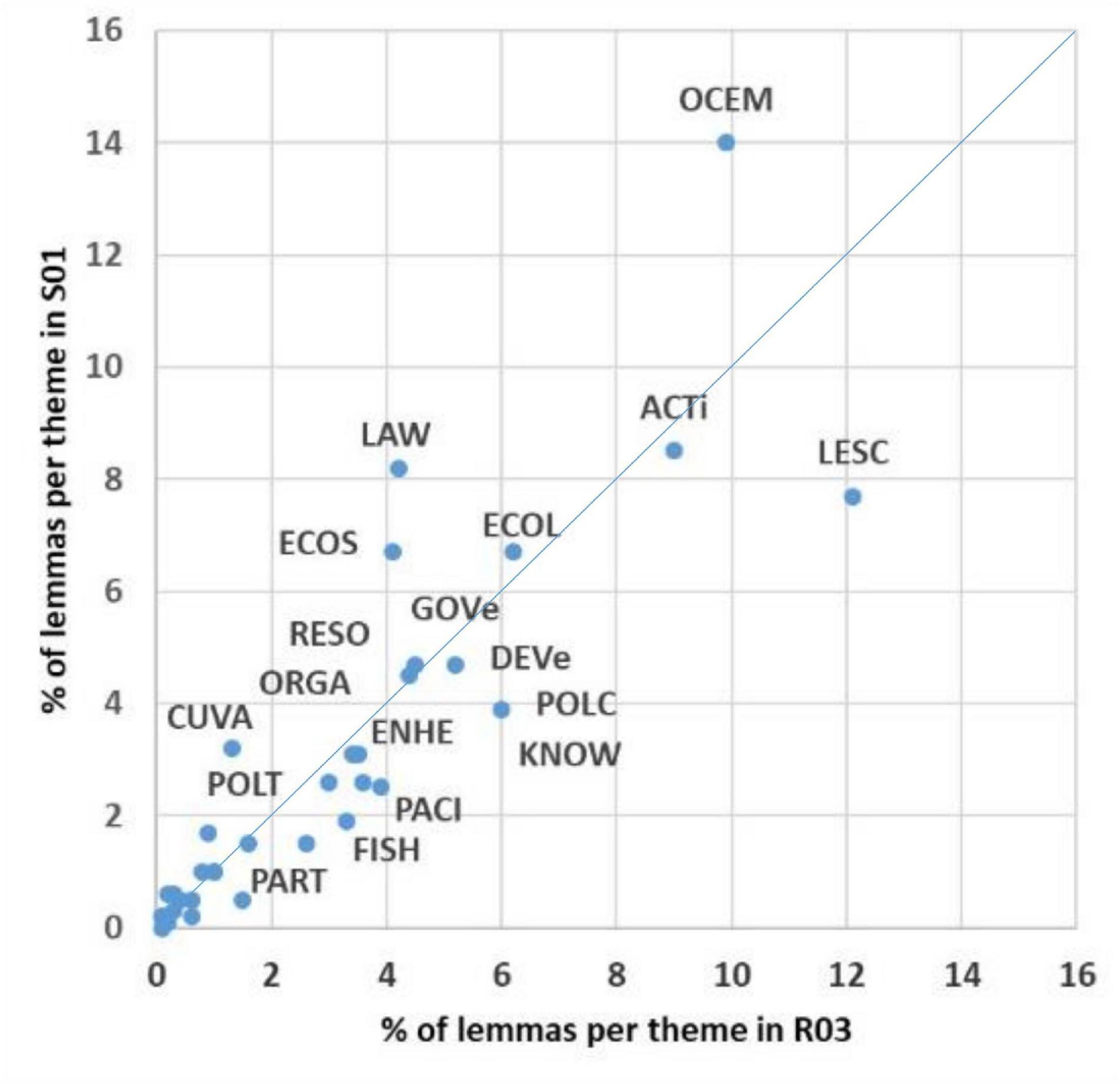
Figure 10. Percentage of lemmas dedicated to each theme in the Framework for a Pacific Oceanscape (RO3; x-axis) and National Ocean Policy (S01; y-axis). Equal percentage of lemmas about the same theme in R03 and S01 align to the diagonal line of parity. The themes above the diagonal are more developed in S01, whereas those below are more developed in R03. Labels of themes below 2% limit on both axes are not given for the readability of the figure.
The juxtaposition of OCEM from being on the regional side of parity when compared with national and regional policy (Figure 9), but on the NOP side of a line of parity with FPO (Figure 10), suggests that there has been an evolution. With the NOP of 2018 more strongly taking on elements of ocean management, and also ecology and society and law than the FPO itself.
These analyses have also uncovered a consolidation among policies, including:
i. Considerable homogeneity between the regional triad of policies (FPO, PIROP, and FRDP) and many of the national policies. In terms of use of constructs the regional triad were similar to national policies but just having regional coverage.
ii. Slightly different were a suite of sector policies but these were largely undifferentiated between national or regional policies. Such regional sector policies (e.g., litter, R05 and fisheries, R09) seemed to be similar to national sector policies but, again, just having regional coverage.
iii. Regionalism, sensu the FPR (of 2014; R01), has been shown to have little connection to both national and regional policies related to the ocean. Through the lens of ocean-related policy, regionalism is a largely absent narrative. However, the Blue Pacific Communique of 2017 seems to partially bridge the gap between ocean policies and regionalism.
iv. The intense overlapping of regional and national policies does not seem to provide required synergies; themes tend to be repetitive rather than synergistic. The NOP of 2018 has largely captured and consolidated policy elements of prior national and regional policies, but there is little evidence that it has created new policy space. Indeed, PIROP and NOP share 33 of the 34 themes, although they are produced 13 years apart (2005 and 2018, respectively); this suggests limited ocean policy evolution. For the Solomon Islands the constructs of the NOP suggest that it is largely a consolidation of national and regional policies rather than a new direction in ocean management and governance.
Discussion
The global marine system has been in decline from multiple anthropogenic pressures including overfishing (Food and Agriculture Organization of the United Nations (FAO), 2018), destruction of marine ecosystems (United Nations General Assembly (UNGA), 2017) and marine litter (Secretariat of the Convention on Biological Diversity (CBD), 2012). The World Ocean Assessment stated that human pressures impact the ocean in complex and cumulative ways, especially from failure to deal quickly with these multiple problems (United Nations General Assembly (UNGA), 2017). The United Nations General Assembly adopted a Resolution in 2015 on “Oceans and the Law of the Sea” (A/RES/70/235) which specifically recognised the importance of Small Island Developing States (SIDS) which tend to be rely heavily on marine resources but have high levels of vulnerability (Article 267). “Transforming Our World: the 2030 Agenda for Sustainable Development” and the associated Sustainable Development Goals (SDGs) (United Nations General Assembly (UNGA), 2015; United Nations, 2017) were premised on addressing the interlinked and indivisible dimensions of sustainable development (economic, social, and environmental) in a holistic and coordinated way (Nerini et al., 2018; Singh et al., 2018). Pacific SIDS undertook a diplomatic campaign to promote international commitment for an ocean-based SDG (now SDG 14), recognising themselves as global ocean guardians (Quirk and Hanich, 2016).
Beyond the international stage policy initiatives have also been progressing at the regional and national scales. For the Pacific, the Blue Pacific Regional Ocean Report (2021) is the first attempt at the regional level to compile a comprehensive, multi-facetted, cross-cutting and holistic review, and stock take of the state of affairs of ocean governance in the region. The conclusion from the BPOR is that progress on implementation has been a mixed but to maintain the oceans health, productivity and resilience requires a cross-sectoral, cooperative, and integrated approach in governance and implementation of plans, activities and measures. However, with the BPOR as a backdrop to the Solomon Islands analysis presented in this work, we find multi-decadal policy development at the national and regional level has largely homogenously and convergently evolved.
At the regional level we find maximum similarity between a triad of policies (PIROP, R02; FPO, R03 and FRDP R04) which were produced from 2005 (PIROP) to 2016 (FRDP). The upshot is that there has been a notable lack of emergence of new policy objectives over this period and even regional sector policies had a medium to high degree of similarity to this regional triad. These polices have developed with thematic interlocking and thus in a largely monotonic way, by way of analogy more akin to cloning or budding.
The analysis presented here demonstrated that the Solomon Islands NOP has a very close allegiance to FPO (and thus PIROP, and FRDP), and also to other national sector-based ocean policies. According to Vince et al. (2017), PIROP was actually envisaged “as a template for the PICTs to adopt and adapt in the development of national policy, reflecting the range of interests, priorities and capacity within the region.” The NOP thus consolidates existing national and regional policy instruments rather than extending or evolving them. In terms of policy content, the NOP in terms of content does not seem to meet the transformative call of the 2030 Agenda for Sustainable Development or regional leaders, such as through the Pohnpei Ocean Statement (POS, R07). However, the collaborative Ocean 12 approach of cross-government working on policy development and implementation, and institutional arrangements set up to facilitate this, may initiate a transformation of ocean management. The NOP states that “more detailed guidance of implementation of this policy will be forthcoming,” so the extent to which the more integrated institutional architecture can deliver in term of implementation will take number of years to determine. With the NOP oversight role mandated to the Ministry of Foreign Affairs and External Trade, the development of the NOP Action Plan, which must find a compromise between conflicting interests, is an important next stage for “keeping the wheels turning” (Keen and Masu, 2019).
Some regional policies were distinguishable from the FPO – NOP nexus. The Framework for Pacific Regionalism (FPR, R01) is relatively dissimilar to all policies (see for example Figure 4). But the vitalness of the Ocean to the identity of the region as extolled by Hau’ofa in his seminal article Our Sea of Islands, does not seem to come out through the FPR. Indeed, the FPO – NOP approach to the ocean from a social- and enviro- centric standpoint, includes few elements about identity and regionalism in the sense of FPR. Increasingly, the broader role of the ocean in multidimensional security and geopolitics is becoming apparent. In contrast the Blue Pacific: Forum Communique (BP, R10) forms a connection with the FPR well as the homogeneous FPO – NOP nexus. The “Blue Pacific” identity is the core driver of collective action to advance the Leaders’ vision under the Framework for Pacific Regionalism and regional priorities such as ocean management and conservation, fisheries, resilience, regional security, and sustainable development. However, as stated in the BPOR, “our ocean custodianship identity lives only through a paper-trail of declarations” and there is a need to revitalise this (OPOC, 2021). BP is thus set out as more of a bridging policy.
Wright et al. (2017) note the usefulness of tailor-made and context-specific regional partnerships for sustainable management, especially for harmonised implementation across SDG14 targets and other ocean related SDGs. Ocean policy has been largely focussed on place-based attributes of natural and non-living resources and socio-economics (Aswani and Hamilton, 2004; McCarter et al., 2018), permitting harvesting and exploitation, balanced by protectionist regimes for biodiversity (OECD, 2020). This ocean view was not brought into the Pacific regionalism narrative, even though it connected the aforementioned Sea of Islands. The Blue Pacific narrative would seem to act more as a bridging policy which links into identity and broader governance and power issues, but also recognises the reliance and resource base of the ocean.
The broader conclusions of this paper challenge the norm of viewing policies at different levels. In the case of the Solomon Islands, national policy has actually increasingly merged with regional policy, through a form of convergent evolution. This has led to minimal differentials between national and regional policy and maybe has constrained the required transformations demanded by Agenda 2030. New directions which build on this merged nexus only arrived through the Blue Pacific Communique in 2017. By way of analogy, the ocean orchestra may have an increasing number of conductors, but they all beat at the same tempo; only by adding a conductor beating at a different tempo does the harmony become disrupted and change.
Data Availability Statement
The raw data supporting the conclusions of this article will be made available by the authors, without undue reservation.
Author Contributions
JH initially conceived the study, but the research was designed jointly by all authors. PNM and JH undertook policy selection and PM, CL, and PNM extracted policy texts. Methodology and computer codes were designed and developed by PM. Data analysis and visualisation was predominantly carried out by CL and PM. All authors contributed to drafting of the manuscript as well as multiple revisions. All authors approved the submitted version.
Funding
This research was funded by the One Ocean Hub project. The One Ocean Hub is a collaborative research for sustainable development project funded by UK Research and Innovation (UKRI) through the Global Challenges Research Fund (GCRF) (Grant Ref: NE/S008950/1). GCRF is a key component in delivering the UK AID strategy and puts UK-led research at the heart of efforts to tackle the United Nations Sustainable Development Goals.
Conflict of Interest
The authors declare that the research was conducted in the absence of any commercial or financial relationships that could be construed as a potential conflict of interest.
Acknowledgments
We wish to acknowledge Robson Hevalao, Ronnelle Panda, and Rosalie Masu from the Ministry of Fisheries and Marine Resources (Government of the Solomon Islands), Peni Suveinakama and Riibeta Abeta from the Office of the Pacific Ocean Commissioner and Transform Aqorau for their support with policy selection. We would also like to acknowledge the wider One Ocean Hub team, especially those from The University of the South Pacific, for the many deliberations which have helped shape this work.
Supplementary Material
The Supplementary Material for this article can be found online at: https://www.frontiersin.org/articles/10.3389/fmars.2021.676944/full#supplementary-material
Footnotes
- ^ In 2015 a National Ocean summit was held by the Government of Solomon Islands, at the recommendation of which the cabinet established the “Ocean 12”; a national steering committee for integrated ocean governance.
- ^ This qualifier should not be taken here with the operational meaning of graph theory, but with an institutional meaning.
- ^ Through the Asia Pacific Energy Portal https://asiapacificenergy.org/ consulted on the 28/02/2021.
References
Allan, C. (1957). Customary Land Tenure in the British Solomon Islands Protectorate. Solomon Islands: Honiara: Western Pacific High Commission.
Aswani, S., and Hamilton, R. J. (2004). Integrating indigenous ecological knowledge and customary sea tenure with marine and social science for conservation of bumphead parrotfish (Bolbometopon muricatum) in the Roviana Lagoon, Solomon Islands. Environmental Conservation. 31, 69–83. doi: 10.1017/S037689290400116X
Barclay, K., and Cartright, I. (2007). Capturing Wealth from Tuna: Case Studies from the Pacific. Solomon Islands: ANU Press, 201–236.
Bergin, A., Brewster, D., and Bachhawat, A. (2019). Ocean Horizons: Strengthening Maritime Security in Indo-Pacific Island States. Sea Change. Canberra AUS: Australian Strategic Policy Institute, 45–48.
Boulet, R., Lajaunie, C., and Mazzega, P. (2019). Law, Public Policies and Complex Systems: Networks in Action. Law, Governance and Technology Series, Vol. 42. Berlin: Springer,Google Scholar
Chan, N. (2018). “Large ocean states”: sovereignty, small islands, and marine protected areas in global oceans governance. Glob. Governance 24, 537–555. doi: 10.1163/19426720-02404005
Dodd, R., Reeve, E., Sparks, E., George, A., Vivili, P., Win-Tin, S. T., et al. (2020). The politics of food in the Pacific: coherence and tension in regional policies on nutrition, the food environment and non-communicable diseases. Public Health Nutr. 23, 168–180. doi: 10.1017/S1368980019002118
Dorah, R. (2007). Towards Integrated National Ocean Policy in the South Pacific: Competing and Conflicting Issues in Ocean Policy-Solomon Islands. UN-Nippon Fellowship Thesis. Available online at: https://www.un.org/Depts/los/nippon/unnff_programme_home/fellows_pages/fellows_papers/dorah_0607_solomon_islands.pdf (accessed February 15, 2021).
Durussel, C., Oyarzuìn, E. S., and Urrutia, O. (2017). Strengthening the legal and institutional framework of the southeast pacific: focus on the BBNJ package elements. Int. J. Mar. Coast. Law. 32, 635–671. doi: 10.1163/15718085-12324051
Ehler, C. N. (2006). A Global Strategic Review: Regional Seas Programme. Nairobi: United Nations Environment Programme, 1–89.
Evans, K., Chiba, S., Bebianno, M. J., Garcia-Soto, C., Ojaveer, H., Park, C., et al. (2019). The global integrated world ocean assessment: linking observations to science and policy across multiple scales. Front. Mar. Sci. 6:298.
Fache, E., Pauwels, S., and Veitayaki, J. (2016). Introduction: Pacific Islanders as ‘Custodians of the Ocean’ Facing Fisheries Challenges. Pacific Credo Publications, 7-18, 2016. Ffhalshs-01735399. Marseille: Pacific Credo Publications.
Food and Agriculture Organization of the United Nations (FAO) (2018). The State of World Fisheries and Aquaculture 2018: Meeting the Sustainable Development Goals. Rome: Food and Agriculture Organization for the United Nations.
Gjerde, K., Boteler, B., Durussel, C., Rochette, J., Unger, S., and Wright, G. (2018). Conservation and Sustainable Use of Marine Biodiversity in Areas Beyond National Jurisdiction: Options for Underpinning a Strong Global BBNJ Agreement through Regional and Sectoral Governance. Strong High Seas Project. 1-24. Available online at: https://www.prog-ocean.org/wp-content/uploads/2018/08/STRONG-High-Seas-Policy-Brief_Options-for-underpinning-BBNJ-agreement.pdf
Graesser, A., Karnavat, A., Pomeroy, V., and Wiemer-Hastings, K. (2000). “Latent semantic analysis captures causal, goal-oriented, and taxonomic structures,” in Proceedings. of the 22nd Annual Conference of the Cognitive-Science-Society. Aug. 13-15, 2000, Univ, (Philadelphia,PA), 184–189.
IPCC (2014). Climate Change 2014: Synthesis Report. Contribution of Working Groups I, II and III to the Fifth Assessment Report of the Intergovernmental Panel on Climate Change. Geneva: IPCC, 151.
Keen, M., and Masu, R. (2019). IB 2019/16 The Blue Pacific in Action: Solomon Islands’ National Ocean Policy. Department of Pacific Affairs, Australian National University. Canberra AUS: Australian National University.
Keen, M. R., Schwarz, A. M., and Wini-Simeon, L. (2018). Towards defining the Blue Economy: practical lessons from Pacific Ocean governance. Mar. Policy 88, 333–341. doi: 10.1016/j.marpol.2017.03.002
Keesing, R. M. (1993). “Kastom re-examined,” in Custom Today, Vol. 6, eds L. Lindstrom and G. White (Milton Park: Taylor & Francis), 587–596. doi: 10.1080/00664677.1993.9967434
Lajaunie, C., and Mazzega, P. (2016). One Health and Biodiversity Conventions. The Emergence of Health Issues in Biodiversity Conventions. IUCN Academy of Environmental Law eJournal. 105–121. Availble online at: https://www.researchgate.net/publication/308209904_ONE_HEALTH_AND_BIODIVERSITY_CONVENTIONS_THE_EMERGENCE_OF_HEALTH_ISSUES_IN_BIODIVERSITY_CONVENTIONS (accessed February 15, 2021).
Lajaunie, C., Mazzega, P., and Boulet, R. (2018). “Health in biodiversity-related conventions: analysis of a multiplex terminological network (1973-2016),” in Big Data in Computational Social Science and Humanities, ed. S. H. Chen (Cham: Springer), 165–182. doi: 10.1007/978-3-319-95465-3_7
McCarter, J., Sterling, E. J., Jupiter, S. D., Cullman, G. D., Albert, S., Basi, M., et al. (2018). Biocultural approaches to developing well-being indicators in Solomon Islands. Ecol. Soc. 23:32.
Nerini, F. F., Tomei, J., To, L. S., Bisaga, I., Parikh, P., Black, M., et al. (2018). Mapping synergies and trade-offs between energy and the sustainable development goals. Nat. Energy 3, 10–15.
OECD (2020). Sustainable Ocean for All: Harnessing the Benefits of Sustainable Ocean Economies for Developing Countries, The Development Dimension. Paris: OECD Publishing, doi: 10.1787/bede6513-en
OPOC (2021). Blue Pacific Ocean Report 2021: A Report by the Pacific Ocean Commissioner to the Pacific Islands Forum Leaders. Suva: Pacific Islands Forum Secretariat.
Pacific Islands Forum Secretariat (2014). The Framework for Pacific Regionalism. Fiji: Pacific Islands Forum Secretariat.
Pacific Islands Forum Secretariat (2015). Ocean Issues and the Office of the Pacific Ocean Commissioner, (Working Paper 12). 9th SPC Heads of Fisheries Meeting, New Caledonia. Fiji: Pacific Islands Forum Secretariat.
Pacific Ocean Commissioner. (2021). Blue Pacific Ocean Report 2021: A Report by the Pacific Ocean Commissioner to the Pacific Islands Forum Leaders. Office of the Pacific Ocean Commissioner. Fiji: Pacific Ocean Commissioner.
Pratt, C., and Brierley, E. (2016). Ocean governance and the ocean commissioner in the pacific author. Soc. Econ. Stud. 65, 133–143.
Pratt, C., and Govan, H. (2010). Our Sea of Islands Our Livelihoods Our Oceania Framework for a Pacific Ocean: A Catalyst for Implementation of Ocean Policy. Suva: SPREP.
Pyć, D. (2019). “The role of the law of the sea in marine spatial planning,” in Maritime Spatial Planning, eds J. Zaucha and K. Gee (Cham: Palgrave Macmillan), 375–395. doi: 10.1007/978-3-319-98696-8_16
Quirk, G and Hanich, Q. (2016). Ocean diplomacy: the Pacific Island countries’ campaign to the UN for an ocean sustainable development goal. Asia-pacific J. Ocean Law Pol. 1, 68–95.
Quirk, G. C., and Harden-Davies, H. R. (2017). Cooperation, competence and coherence: the role of regional ocean governance in the south west pacific for the conservation and sustainable use of biodiversity beyond national jurisdiction. Int. J. Mar. Coast. Law. 32, 672–708. doi: 10.1163/15718085-13204022
Secretariat of the Convention on Biological Diversity (CBD) and the Scientific and Technical Advisory PanelŮGEF (2012). Impacts of Marine Debris on Biodiversity: Current Status and Potential Solutions Montreal, Technical Series No. 67.
Searight, A., Harding, B., and Tran, M. K. (2019). Pacific Regionalism and Regional Architecture Report Title: Strengthening the U.S.–Pacific Islands Partnership Report, Center for Strategic and International Studies. Washington, DC: Center for Strategic and International Studies.
Singh, G. G., Hilmi, N., Bernhardt, J. R., Cisneros-Montemayor, A. M., Cashion, M., Ota, Y., et al. (2018). Climate impacts on the ocean are making the Sustainable Development Goals a moving target travelling away from us. People Nat. 1, 317–330. doi: 10.1002/pan3.26
SINOP (2018). Solomon Islands National Ocean Policy: November 2018, Government of the Solomon Islands, Ocean 12. Solomon Islands: SINOP.
Sloan, J., Chand, K., and Samuela, E. (2020). Fiji’s first National Ocean Policy Analysis and Submission. Fiji: Siwatibau and Sloan Law.
Song, A. M., Cohen, P. J., Hanich, Q., Morrison, T. H., and Andrew, N. (2019). Multi-scale policy diffusion and translation in Pacific Island coastal fisheries. Ocean Coast. Manag. 168, 139–149. doi: 10.1016/j.ocecoaman.2018.11.005
Transform, A. (2007). Governance and development in solomon islands: a fisheries case study. J. Pacific History 42, 247–254.
UN ESCAP. (2020). Asia and the Pacific SDG Progress Report 2020. Bangkok: United Nations Publications, 1–104..
UN General Assembly. (2003). Resolution Adopted by the General Assembly: 57/141-Oceans and the law of the sea. Fifty-seventh session Agenda item 25 (a) [A/RES/57/141]. New York NY: UN General Assembly.
UNCLOS (1982). The United Nations Convention on the Law of the Sea. 1-202. Available online at : http://www.un.org/depts/los/convention_agreements/texts/unclos/unclos_e.pdf (accessed 03 03, 2021).
United Nations (2017). Regional roadmap for implementing the 2030 Agenda for Sustainable Development in Asia and the Pacific, E/ESCCAP/FSD(4)/2/Rev.1. Bangkok: Economic and Social Commission for Asia Pacific.
United Nations General Assembly (UNGA) (2015). Resolution adopted by the General Assembly on 23 December 2015: 70/235. Oceans and the law of the sea [A/RES/70/235]. Available online at: https://www.un.org/en/development/desa/population/migration/generalassembly/docs/globalcompact/A_RES_70_235.pdf
United Nations General Assembly (UNGA) (2017). The First Global Integrated Marine Assessment (World Ocean Assessment). United Nations General Assembly and its Regular Process for Global Reporting and Assessment of the State of the Marine Environment, including Socioeconomic Aspects. Available online at: http://www.un.org/Depts/los/global_reporting/WOA_RegProcess.htm
UNOCHA (United National Office for the Coordination of Humanitarian Affairs) (2021). Solomon Islands. Available online at: https://www.unocha.org/office-pacific-islands/solomon-islands (accessed 05 04, 2021).
Vierros, M., Suttle, C. A., Harden Davies, H., and Burton, G. (2016). Who owns the ocean? Policy issues surrounding marine genetic resources. Limnol. Oceanogr. Bull. 25, 29–35.
Vince, J., Brierley, E., Stevenson, S., and Dunstan, P. (2017). Ocean governance in the South Pacific region: progress and plans for action. Mar. Policy 79, 40–45. doi: 10.1016/j.marpol.2017.02.007
WORLD BANK (2017). ). Pacific Possible: Long-Term Economic opportunities and Challenges for Pacific Island Countries. Pacific possible series. Washington, D.C: World Bank Group.
Wright, G., Schmidt, S., Rochette, J., Shackeroff, J., Unger, S., Waweru, Y., Müller, A. (2017). Partnering for a Sustainable Ocean: The Role of Regional Ocean Governance in Implementing SDG14. PROG: IDDRI. IASS, TMG & UN Environment.
WSSD (2002). United Nations Report of the World Summit on Sustainable Development, Johannesburg, South Africa [A/CONF.199/20∗]. New York NY: United Nations, 1–23. ISBN 92-1-104521-5.
Keywords: ocean, policy, Pacific, regional, Solomon Islands, sustainability, network, lexicometry
Citation: Hills JM, Lajaunie C, Maharaj PN and Mazzega P (2021) Orchestrating the Ocean Using a National Ocean Policy: The Case of the Solomon Islands. Front. Mar. Sci. 8:676944. doi: 10.3389/fmars.2021.676944
Received: 06 March 2021; Accepted: 07 June 2021;
Published: 30 June 2021.
Edited by:
Lucia Fanning, Dalhousie University, CanadaReviewed by:
Anne-Maree Schwarz, University of Wollongong, AustraliaJennifer Leigh Bailey, Norwegian University of Science and Technology, Norway
Copyright © 2021 Hills, Lajaunie, Maharaj and Mazzega. This is an open-access article distributed under the terms of the Creative Commons Attribution License (CC BY). The use, distribution or reproduction in other forums is permitted, provided the original author(s) and the copyright owner(s) are credited and that the original publication in this journal is cited, in accordance with accepted academic practice. No use, distribution or reproduction is permitted which does not comply with these terms.
*Correspondence: Jeremy M. Hills, amVyZW15LmhpbGxzQHVzcC5hYy5mag==
 Jeremy M. Hills
Jeremy M. Hills Claire Lajaunie
Claire Lajaunie Payal N. Maharaj
Payal N. Maharaj Pierre Mazzega
Pierre Mazzega